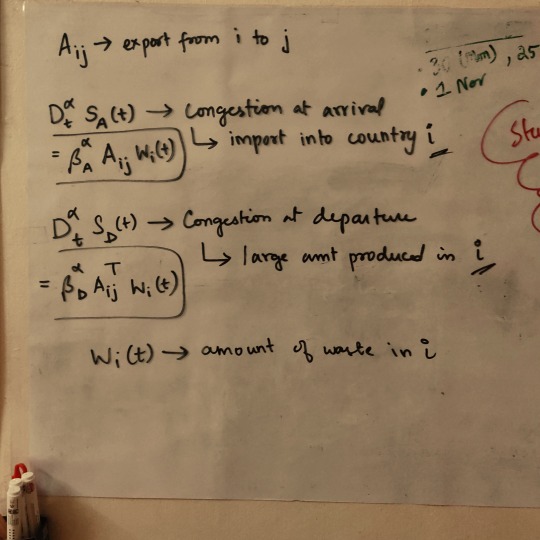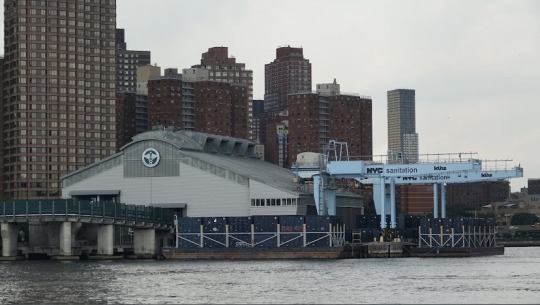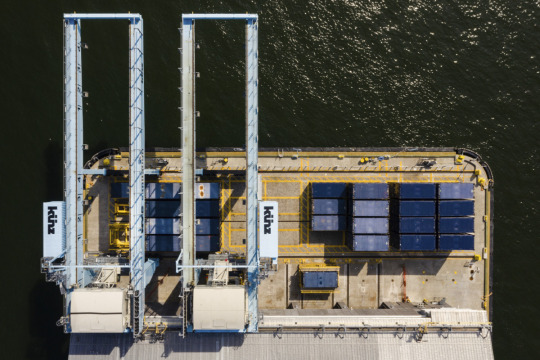#waste management
Text
The average American produces 1,704 pounds of garbage per year, roughly three times the global average, according to a new report by the research firm Verisk Maplecroft.
Across 194 countries, the researchers found that the world produces 2.3 billion tons of municipal solid waste each year, which is enough to fill 822,000 Olympic-sized pools. Of this waste, just 16% is recycled, while 46% is disposed of unsustainably in ways that harm the environment.
[...]
Countries like the US and Singapore are reaching their landfill capacity, while countries like China and Malaysia have refused to continue accepting trash exported from Western nations.
Although the United States accounts for 4% of the global population, it’s responsible for 12% of the municipal solid waste that’s created, and historically would ship a lot of trash to other countries.
China and India, meanwhile, account for 36% of the global population, but generate only 27% of all waste.
also according to a lot of studies the majority of garbage in the US is food waste which can 100% be composted and is the most environmentally destructive when sent to a landfill because it creates methane

from this source
America has got a waste problem. An average American produces about 4.40 pounds of garbage per day and approximately three-quarters of a tonne per year. If you are thinking “this can’t possibly be right, there is no way I produce THAT MUCH”, get ready for another blow. The U.S.A holds the record of producing the highest amount of garbage in the world, more than Russia, India, and even China.
All that trash has to end up somewhere and as a result, the 2,000 active landfills in the US are reaching their capacity. What will happen when we run out of the room? Well, let’s ask a better question. What can we do to manage our waste better and prevent a catastrophe?
Overfilled landfills are a big problem. Some states decide to simply burn the landfills, as burning reduces the volume of the trash in the landfill significantly. This frees up a lot of space, but the problem of toxic gasses and fumes being released into the atmosphere persists. Not only do these gasses contribute to climate change, but they can also deteriorate human health and end up costing millions in medical expenses.
On the other hand, simply leaving the landfills as they pose other issues. The chemical and biological reactions taking place in landfills can create a lot of issues as these chemicals leach into the ground and contaminate water that municipalities may extract for use in their water systems. The piles of organic garbage also release harmful methane, a greenhouse gas more 86 times more potent than carbon dioxide. So, what can be done to alleviate these issues?
326 notes
·
View notes
Text
"A Delhi-based engineer has designed a replacement for polystyrene packaging out of “rice stubble” the dead stalks left over after the rice season in India, millions of tons of which are burned every year.
They say wisdom oft comes from the mouths of babes, and Mr. Arpit Dhupar was at first left scratching his head when his young nephew drew a picture of the world with a grey sky.
Everything else was normal, green grass, yellow sun, white and brown mountains; why was the sky grey? It dawned on him that his nephew was drawing the sky as he saw it every year when the rice stubble was burned: grey.
“We shouldn’t live in a world where we have to explain to kids that the sky should be painted blue. It should be a given,” he told The Better India.
So he launched a new business venture called Dharaksha Ecosystems in order to tackle the rice stubble problem. Essentially, the farmers need it cleared off their land asap after harvest. Its high moisture content means it’s not useful for stove fuel, so they burn it in massive pyres.
In his factory, he turns 250 metric tons of rice stubble harvested from 100 acres of farmland in Punjab and Haryana into packaging, while paying the farmers a rate of $30 per acre for something they would usually burn.

Dhupar originally wanted to use mushrooms to rapidly biodegrade baled stacks of rice stubble, but found that the fungus left behind a metabolite that wasn’t biodegradable—in other words, he’d have to create a waste problem to solve a waste problem.
Over time he realized that the filaments that make up the subterranean structure of the mushrooms, called mycelium, were acting as a sort of binding agent, turning the baled stubble into something durable.
“This wasn’t a waste material but could be a usable one,” said Dhupar. “Through bio-fabrication, we could use the stubble waste to create a material similar to [polystyrene], but one that was biodegradable.”
There are a lot of these sorts of sustainable packaging ideas floating around, invented by people who rarely have experience in markets and commerce. This is not the case with Dhupar’s stubble packaging.
He has already prevented over half a million pounds of polystyrene from entering landfills since launching his product, which has numerous, exceptional properties.
They sell around 20 metric tons of their product every month, making about $30.5 thousand dollars per annum, mostly by selling to glassware companies."
-via Good News Network, 3/22/23
#sustainability#recycling#fungi#mycelium#mushrooms#india#delhi#green technology#waste management#rice#agriculture#packaging#glassware#good news#hope
346 notes
·
View notes
Text

Glen posting this while being paired with the Number 1 ranked golfer 😆
Scottie better be prepared for a Happy Gilmore moment! It’s called the peoples open for a reason lol
72 notes
·
View notes
Text
“This is the Old Ladies Against Underwater Garbage,” or OLAUG for short, explains retired psychologist Susan Baur. The youngest member of the group that Baur founded is 65; at 82, she’s the oldest.
😭
defs read the entire article if you can bc its so good
#this is the best#good news#nature#environmentalism#environment#water#water is life#waste management#trash#lakes
57 notes
·
View notes
Photo

Waste Management
Artist: Aaron Miller
TCG Player Link
Scryfall Link
EDHREC Link
25 notes
·
View notes
Text
Nearly half of Montreal's 19 boroughs aren't recycling glass, despite telling residents on the city website they can put it in their blue bin or bag.
Recycling in eight boroughs is taken to the sorting centre in the city's Saint-Michel neighbourhood, which is managed by the company Ricova. The 11 other boroughs' recycling goes to a new $47-million facility in Lachine, operated by another company contracted by the city, Société VIA.
Both sorting centres have had trouble separating glass from other recyclables, as well as cleaning it — but the Saint-Michel centre is the latest to have come under scrutiny for not even trying.
The 20,000 tonnes of glass Ricova collects in Montreal ends up in landfills or is ground into powder and used as landfill cover as a replacement for sand. Landfill cover is spread over garbage at the end of each day to minimize odours, flyaways and prevent animals from getting into it. [...]
Continue Reading.
Tagging: @politicsofcanada
76 notes
·
View notes
Text

Wonderful Things That May or May Not Be Wonderful!!!
Well, after talking about figs yesterday, what do we do about figs that don't get eaten and have become past their prime? Well, we could just leave them there but that would get unsanitary. What we need to do is put them inside something where all the disgusting and discarded objects in one's home can go so they can be transported to an even larger place where all the disgusting and discarded objects in everyone's’ home can go. That's right, I'm talking about a trash can or bin or dumpster or whatever you call it! Expired food? Throw them in! Used napkins? Throw them in! Obliterated game consoles? Throw them in! Direct to DVD animated movies? Throw them in with certain exceptions! Trash-tier anime waifus? THROW THEM IN! That's right! If you don't want something anymore, just chuck it in the bin and forget about till Monday! Waste not, want not but if we are going to waste, it's nice to know that there is a plastic and/or metal canister where all the waste can disappear to for a brief time then disappear forever! Just remember to not put anything living in there. Life is precious, don't waste it! That would be messed up. So yeah, trash cans are wonderful...and smelly.
#wonderful#trash cans#trash bins#dumpsters#receptacle#sanatation#rubbish#discarded#throw it away#disgusting#stinky#clean#plastic#metal#garbage#waste management#waste#expired#waste disposal
46 notes
·
View notes
Text
youtube
Air pollution kills millions each year, especially in the world’s megacities. But we found some surprising news: In many places, it’s actually getting better! Here’s how megacities around the world are already making their air cleaner and safer.
#planeta #smog #airpollution
We're destroying our environment at an alarming rate. But it doesn't need to be this way. Our new channel Planet A explores the shift towards an eco-friendly world — and challenges our ideas about what dealing with climate change means. We look at the big and the small: What we can do and how the system needs to change. Every Friday we'll take a truly global look at how to get us out of this mess.
Credits:
Author: Kira Schacht
Video Editor: Frederik Willmann
Supervising Editor: Kiyo Dörrer
Fact-check: Kirsten Funck
With thanks for interviews (included and not):
Rafay Alam:
/ rafay_alam
Zoe Chafe: https://www.c40.org/our-team/zoe-chafe/
Sophie Gumy, Technical Officer at WHO's Department of Environment, Climate Change and Health
Frank Hammes, IQAir: https://www.iqair.com/
Bhavreen Kandhari:
/ bhavreen-kandhari-8028...
Abid Omar:
/ abidomar
Read more:
WHO Ambient (outdoor) air pollution:
https://www.who.int/news-room/fact-sh...
C40 – Air quality:
https://www.c40.org/what-we-do/scalin...
Pakistan Air Quality Initiative:
/ pakairquality
Chapters:
00:00 Intro
00:46 The problem
01:31 Our analysis
02:00 The causes
02:36 Transport
04:04 Industry
04:45 Waste
05:39 Energy
07:12 What now
09:46 Outro
#dw planet a#solarpunk#air pollution#smog#lung health#air quality#air health#health#fossil fuels#car exhaust#electric vehicles#ev#electric car#bicycle#foot traffic#Youtube#waste management#clean energy#green energy
15 notes
·
View notes
Text
youtube
The contrast between the compact, secure storage of the discharged nuclear fuel ― 95% of which is reusable ― and the discharge of fossil-fuel wastes directly into our environment could scarcely be more striking.
10 notes
·
View notes
Text
It is August 1854, and London is a city of scavengers. Just the names alone read now like some kind of exotic zoological catalogue: bone-pickers, rag-gatherers, pure-finders, dredgermen, mud-larks, sewer-hunters, dustmen, night-soil men, bunters, toshers, shoremen. These were the London underclasses, at least a hundred thousand strong. So immense were their numbers that had the scavengers broken off and formed their own city, it would have been the fifth-largest in all of England. But the diversity and precision of their routines were more remarkable than their sheer number. Early risers strolling along the Thames would see the toshers wading through the muck of low tide, dressed almost comically in flowing velveteen coats, their oversized pockets filled with stray bits of copper recovered from the water's edge. The toshers walked with a lantern strapped to their chest to help them see in the predawn gloom, and carried an eight-foot-long pole that they used to test the ground in front of them, and to pull themselves out when they stumbled into a quagmire. The pole and the eerie glow of the lantern through the robes gave them the look of ragged wizards, scouring the foul river's edge for magic coins. Beside them fluttered the mud-larks, often children, dressed in tatters and content to scavenge all the waste that the toshers rejected as below their standards: lumps of coal, old wood, scraps of rope.
Above the river, in the streets of the city, the pure-finders eked out a living by collecting dog shit (colloquially called “pure”) while the bone-pickers foraged for carcasses of any stripe. Below ground, in the cramped but growing network of tunnels beneath London's streets, the sewer-hunters slogged through the flowing waste of the metropolis. Every few months, an unusually dense pocket of methane gas would be ignited by one of their kerosene lamps and the hapless soul would be incinerated twenty feet below ground, in a river of raw sewage.
The scavengers, in other words, lived in a world of excrement and death. Dickens began his last great novel, Our Mutual Friend, with a father-daughter team of toshers stumbling across a corpse floating in the Thames, whose coins they solemnly pocket. “What world does a dead man belong to?” the father asks rhetorically, when chided by a fellow tosher for stealing from a corpse. “'Tother world. What world does money belong to? This world.” Dickens' unspoken point is that the two worlds, the dead and the living, have begun to coexist in these marginal spaces. The bustling commerce of the great city has conjured up its opposite, a ghost class that somehow mimics the status markers and value calculations of the material world. Consider the haunting precision of the bone-pickers' daily routine, as captured in Henry Mayhew's pioneering 1844 work, London Labour and the London Poor:
It usually takes the bone-picker from seven to nine hours to go over his rounds, during which time he travels from 20 to 30 miles with a quarter to a half hundredweight on his back. In the summer he usually reaches home about eleven of the day, and in the winter about one or two. On his return home he proceeds to sort the contents of his bag. He separates the rags from the bones, and these again from the old metal (if he be luckly enough to have found any). He divides the rags into various lots, according as they are white or coloured; and if he have picked up any pieces of canvas or sacking, he makes these also into a separate parcel. When he has finished the sorting he takes his several lots to the ragshop or the marine-store dealers, and realizes upon them whatever they may be worth. For the white rags he gets from 2d. to 3d. per pound, according as they are clean or soiled. The white rags are very difficult to be found; they are mostly very dirty, and are therefore sold with the coloured ones at the rate of about 5 lbs. for 2d.
The homeless continue to haunt today's postindustrial cities, but they rarely display the professional clarity of the bone-picker's impromptu trade, for two primary reasons. First, minimum wages and government assistance are now substantial enough that it no longer makes economic sense to eke out a living as a scavenger. (Where wages remain depressed, scavenging remains a vital occupation; witness the perpendadores of Mexico City). The bone collector's trade has also declined because most modern cities possess elaborate systems for managing the waste generated by their inhabitants. (In fact, the closest American equivalent to the Victorian scavengers – the aluminium-can collectors you sometimes see hovering outside supermarkets – rely on precisely those waste-management systems for their paycheck.) But London in 1854 was a Victorian metropolis trying to make do with an Elizabethan public infrastructure. The city was vast even by today's standards, with two and a half million people crammed inside a thirty-mile circumference. But most of the techniques for managing that kind of population density that we now take for granted – recycling centers, public-health departments, safe sewage removal – hadn't been invented yet.
And so the city itself improvised a response – an unplanned, organic response, to be sure, but at the same time a response that was precisely contoured to the community's waste-removal needs. As the garbage and excrement grew, an underground market for refuse developed, with hooks into established trades. Specialists emerged, each dutifully carting goods to the appropriate site in the official market: the bone collectors selling their goods to the bone-boilers, the pure-finders selling their dog shit to tanners, who used the “pure” to rid their leather goods of the lime they had soaked in for weeks to remove animal hair. (A process widely considered to be, as one tanner put it, “the most disagreeable in the whole range of manufacture.”)
We're naturally inclined to consider these scavengers tragic figures, and to fulminate against a system that allowed so many thousands to eke out a living by foraging through human waste. In many ways, this is the correct response. (It was, to be sure, the response of the great crusaders of the age, among them Dickens and Mayhew.) But such social outrage should be accompanied by a measure of wonder and respect: without any central planner coordinating their actions, without any education at all, this itinerant underclass managed to conjure up an entire system for processing and sorting the waste generated by two million people. The great contribution usually ascribed to Mayhew's London Labour is simply his willingness to see and record the details of these impoverished lives. But just as valuable was the insight that came out of that bookkeeping, once he had run the numbers: far from being unproductive vagabonds, Mayhew discovered, these people were actually performing an essential function for their community. “The removal of the refuse of a large town,” he wrote, “is, perhaps, one of the most important of social operations.” And the scavengers of Victorian London weren't just getting rid of that refuse – they were recycling it.
— The Ghost Map: The Story of London's Most Terrifying Epidemic - and How it Changed Science, Cities and the Modern World (Steven Johnson)
#book quotes#steven johnson#the ghost map#the ghost map: the story of london's most terrifying epidemic - and how it changed science cities and the modern world#history#sanitation#waste management#recycling#economics#poverty#employment#labour#sociology#homelessness#welfare#authors#britain#victorian britain#england#london#thames#mudlarks#toshers#tanners#charles dickens#henry mayhew
49 notes
·
View notes
Text
Theravada & Zoomo - Resource Recovery
5 notes
·
View notes
Text
My boss at my work placement asked me to make some graphics to help her teach kids about waste diversion




I don't love the donate and repair one but all in all I really like these guys
#ink#marker art#traditional art#drawing#waste management#waste diversion#hazardous waste#electronic waste#garbage
10 notes
·
View notes
Text
Untangling articles and Noodles


15/100 days of productivity • 8-11-23, Wednesday
I am a teaching assistant for an MSc Computational Physics Practicals class and they have their final exams today. So I was in the exam hall supervising the students and also having a conversation with the external examiner who had come from a nearby university. My advisor had told him about my final PhD plans and we were discussing how to best do them.
Had a long, intellectual discussion with my friend about a paper - especially about what's wrong in that paper. It's been a long time since such a stimulating conversation. I was trying understand the equations (you can see them in the picture of the white board), which describe a global network of wastes: how countries export and import, and manage waste.
Made soupy pepper noodles for dinner. Was so good and soothing for my cold. Do you guys have a favourite sick-food?
Tasks for today
Main task: Invigilation for MSc Computational Physics Practicals
Plan for the upcoming projects and research visits
Mail People
• Irene - funds
• Merten - set up a zoom call for discussion
• Aleta - project update
• Leah - Supernova Foundation Webinar Ideas
#gradblr#dark academia#chaotic academia#gradschool aesthetic#phdblr#phd aesthetic#phd life#comfort food#maggi#noodles#100 days of productivity#100dop#waste management#scientific research#journal reading#how to read a journal article
17 notes
·
View notes
Text
The main contractor in charge of constructing the Site C hydroelectric dam project near Fort St. John in northeastern B.C. has been hit with a $1.1 million fine for dumping contaminated drainage water into the Peace River.
The penalty was imposed after Peace River Hydro Partners pleaded guilty in provincial court in Fort St. John on Monday to depositing a deleterious substance into fish-bearing waters, a violation of the federal Fisheries Act, according to Environment and Climate Change Canada,
The federal agency says its enforcement officers discovered that in 2018, the contractor discharged 3,300 cubic metres of drainage water with a high concentration of metals into the Peace River due to their water treatment system's inadequate capacity.
"A sample of the drainage water collected on Sept. 9, 2018, determined that it contained a concentration of aluminum that was acutely lethal to fish," said Environment and Climate Change Canada in a news release on Wednesday. [...]
Continue Reading.
Tagging: @politicsofcanada
#cdnpoli#British Columbia#Fort St. John#Peace River#waste management#water pollution#renewable energy
33 notes
·
View notes
Text
instagram

#endisraelsgenocide#human health#children health#human rights#children rights#infection#disease#waste management#epidemic#palestine#free gaza#i stand with palestine 🇵🇸#gaza#free palestine 🇵🇸#gaza strip#free palestine#gazaunderattack#palestine resources#israeli terrorism#israel is a terrorist state#israel is committing genocide#Instagram
5 notes
·
View notes



